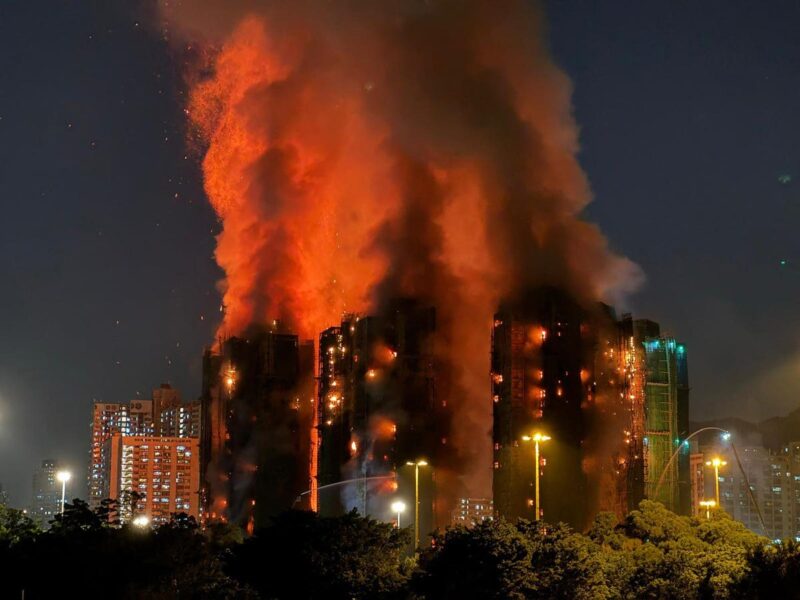TOPSHOT – Thick smoke and flames rise as a major fire engulfs several apartment blocks at the Wang Fuk Court residential estate in Hong Kong’s Tai Po district on November 26, 2025. (Photo by Yan ZHAO / AFP via Getty Images)
AFP via Getty Images
As of Friday morning, the death toll from the tragic fire in a Hong Kong housing complex exceeded 120, according to published reports. The Tao Po district blaze is mostly under control, but several people who were in the two-thousand unit complex are still missing. While the primary focus of investigators is bamboo scaffolding, structural characteristics, and maintenance issues, I was curious about what role weather, particularly the Asian monsoon, may have played.
Typical wind pattern in November as described by the Webster-Yang Monsoon Index.
NOAA Climate Prediction Center website
The region was very dry at the time of the fires with relative humidities near or below 50%. Additionally, the northeast monsoon ushered in dry northerly winds into the region. What’s the northeast monsoon? In the U.S., many people incorrectly describe any significant rainstorm as a monsoon. According to the National Weather Service, “The word monsoon is derived from the Arabic word mausim, which means season.” The NWS website went on to say, “Traders plying the waters off the Arabian and Indian coasts noted for centuries that dry northeast winds in the winter suddenly turn to the southwest during the summer.” Monsoons can be found all over the planet including African, North America, and Southeast Asia.
Global precipitation for November derived from NASA IMERG satellite-based data and averaged over the period 2001 to 2022.
NASA
Seasonal shifts in wind patterns, which are the defining feature of monsoons, play a major role in the cycle of dryness (or wetness) of a region. In fact, many people in the U.S. Southwest rely on the nourishing rains from the wind shifts associated with the North American Monsoon.
During late fall and winter, the East Asian monsoon features northeasterly winds and a general offshore flow pattern. During the warm season, as the land mass warms, the wind shifts to an onshore flow, which ushers in the rainy season. In the graphic above, global precipitation in November is shown. The impact of the winter East Asian monsoon is evident as most of the precipitation is offshore. The near-equatorial Intertropical Convergence Zone rainband is also clearly evident. The graphic below shows precipitation for the same period of years but in the month of June. The warm season wind reversal brings more rainfall into Hong Kong.
Global precipitation for June derived from NASA IMERG satellite-based data and averaged over the period 2001 to 2022.
NASA
During my previous time at NASA, I served as the Deputy Project Scientist for the Global Precipitation Measurement Mission. While writing this article, I decided to be a writer and a scientist. Using available data and the NASA Giovanni analysis tool, I plotted typical seasonal rainfall rates averaged over an area of Southeast Asia that includes Hong Kong. In the graphic below, you can see that fall and winter in this region is drier.
Monthly-averaged precipitation rate over the Hong Kong region from 1998 to 2024. The blue line represents winter and the orange line represend fall.
NASA
My takeaway point is that there is nothing particularly unusual about dry conditions in Hong Kong in November. However, the impact of the cool season monsoon was evident. In fact, high fire risk warnings had been in place much of the week in Hong Kong due to dry conditions. The Hong Kong Observatory, which uses a two-level fire warning system, issued a “Red fire danger” on Monday signaling extreme risk from fire. That warning was still in effect when the fire started. The other warning level, yellow, is used for high risk. Low humidity, high winds and that state of vegetation in the region are factors considered when issuing the appropriate warning level.
An aerial view of the burnt buildings after a deadly fire that started Wednesday at Wang Fuk Court, a residential estate in the Tai Po district of Hong Kong’s New Territories, Friday, Nov. 28, 2025. (AP Photo/Ng Han Guan)
Copyright 2025 The Associated Press. All rights reserved
.









